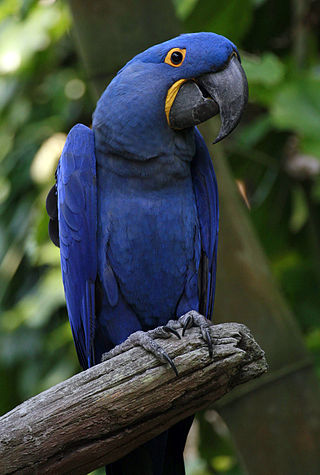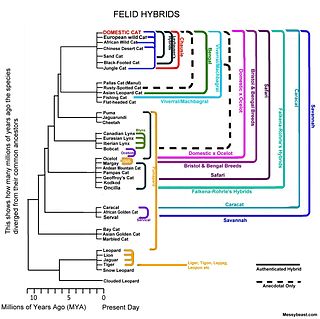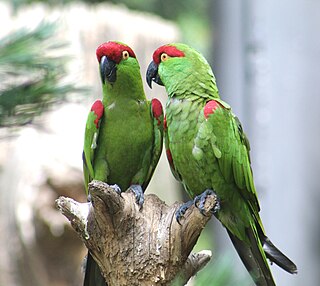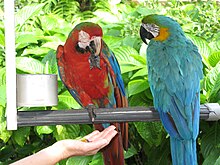Macaws are a group of New World parrots that are long-tailed and often colorful. They are popular in aviculture or as companion parrots, although there are conservation concerns about several species in the wild.

Spix's macaw, also known as the little blue macaw, is a macaw species that was endemic to Brazil. It is a member of tribe Arini in the subfamily Arinae, part of the family Psittacidae. It was first described by German naturalist Georg Marcgrave, when he was working in the State of Pernambuco, Brazil in 1638 and it is named for German naturalist Johann Baptist von Spix, who collected a specimen in 1819 on the bank of the Rio São Francisco in northeast Bahia in Brazil. This bird has been completely extirpated from its natural range, and following a several-year survey, the IUCN officially declared it extinct in the wild in 2019. However, two batches of individuals have since been reintroduced into the wild in 2022.

The scarlet macaw is a large yellow, red and blue Neotropical parrot native to humid evergreen forests of the Americas. Its range extends from southeastern Mexico to Peru, Ecuador, Colombia, Bolivia, Venezuela and Brazil in lowlands of 500 m (1,600 ft) up to 1,000 m (3,300 ft), the Caribbean island of Trinidad, as well as the Pacific island of Coiba. Formerly, the northern extent of its range included southern Tamaulipas. In some areas, it has suffered local extinction because of habitat destruction, or capture for the parrot trade, but in other areas, it remains fairly common. It is the national bird of Honduras. Like its relative the blue-and-yellow macaw, the scarlet macaw is a popular bird in aviculture as a result of its striking plumage.

A companion parrot is a parrot kept as a pet that interacts abundantly with its human counterpart. Generally, most species of parrot can make excellent companions, but must be carefully managed around other common pet species like dogs and cats as they might be hostile towards them.

The red-and-green macaw, also known as the green-winged macaw, is a large, mostly-red macaw of the genus Ara.

The hyacinth macaw, or hyacinthine macaw, is a parrot native to central and eastern South America. With a length of about one meter it is longer than any other species of parrot. It is the largest macaw and the largest flying parrot species; the flightless kākāpō of New Zealand outweighs it at up to 3.5 kg. While generally easily recognized, it could be confused with the smaller Lear's macaw. Habitat loss and the trapping of wild birds for the pet trade have taken a heavy toll on their population in the wild, so the species is classified as Vulnerable on the International Union for Conservation of Nature's Red List, and it is protected by its listing on Appendix I of the Convention on International Trade in Endangered Species of Wild Fauna and Flora (CITES).

The blue-throated macaw, also known as the Caninde macaw or Wagler's macaw, is a macaw endemic to a small area of north-central Bolivia, known as Los Llanos de Moxos. In 2014 this species was designated by law as a natural patrimony of Bolivia. Until 2010, it was hunted by native people to make feathered "Moxeño" headdresses for "machetero" ritual dances.

The red-bellied macaw, also known as Guacamaya Manilata, is a medium-sized, mostly green parrot, a member of a group of large Neotropical parrots known as macaws. It is the largest of what are commonly called "mini-macaws". The belly has a large maroon patch which gives the species its name.

A felid hybrid is any of a number of hybrids between various species of the cat family, Felidae. This article deals with hybrids between the species of the subfamily Felinae.

Captive breeding, also known as captive propagation, is the process of keeping plants or animals in controlled environments, such as wildlife reserves, zoos, botanic gardens, and other conservation facilities. It is sometimes employed to help species that are being threatened by the effects of human activities such as climate change, habitat loss, fragmentation, overhunting or fishing, pollution, predation, disease, and parasitism.

The thick-billed parrot is a medium-sized parrot endemic to Mexico that formerly ranged into the southwestern United States. Its position in parrot phylogeny is the subject of ongoing discussion; it is sometimes referred to as thick-billed macaw or thick-billed conure. In Mexico, it is locally called guacamaya ("macaw") or cotorra serrana. Classified internationally as Endangered through IUCN, the thick-billed parrot's decline has been central to multiple controversies over wildlife management. In 2018, the estimated wild population in Mexico was 1,700.

The blue-winged macaw, in aviculture more commonly known as Illiger's macaw, is a species of small macaw found in central and eastern South America. The second name is in honor of the German ornithologist Johann Karl Wilhelm Illiger. It was previously placed in the genera Ara or Propyrrhura. Blue-winged macaws have been known to reach an age of 50–60 years.
Tony Silva, also known as Antonio H. Silva is an American aviculturist and ornithologist, and the author of books and articles about parrots. From 1989 to 1992, he was curator of birds at Loro Parque, the largest parrot park in the world. In 1996, he was convicted of conspiring to smuggle rare parrots into the United States and of tax evasion.
Birds International Incorporated or BII is a company working in the field of aviculture established in 1975 by Antonio de Dios. It is located in Quezon City near Manila, the capital of the Philippines.
Antonio de Dios is a "bird aficionado" known in the relevant circles from the Philippines who established in 1975 Birds International, Inc., a company working in the field of aviculture.

The international trade in parrots is a lucrative enterprise, and forms an important part of the international wildlife trade. As parrots have become increasingly endangered, many countries have placed restrictions on the trade and/or prohibited the trade altogether. Despite the restriction on trade in many countries however, the market still operates both legally and illegally. A big factor that attempts to keep the control in international trade is CITES. The Convention of International Trade in Endangered Species of Wildlife Fauna and Flora was established in 1975, and consists of 184 parties which includes 183 countries along with the European Union. CITES offers three different degrees of protection for around 38,000 species around the world.

The Arini tribe of the neotropical parrots is a monophyletic clade of macaws and parakeets characterized by colorful plumage and long, tapering tails. They occur throughout Mexico, Central America, and South America, the Caribbean and the southern United States. One genus and several species are extinct; another genus is extinct in the wild. Two species are known only through subfossil remains. About a dozen hypothetical extinct species have been described, native to the Caribbean area. Among the Arini are some of the rarest birds in the world, such as Spix's macaw, which is extinct in the wild – fewer than 100 specimens survive in captivity. It also contains the largest flighted parrot in the world, the hyacinth macaw. Some species, such as the blue-and-yellow macaw and sun conure are popular pet parrots.
The American Federation of Aviculture, Inc. (AFA) is a national organization dedicated to aviculture, whose purpose is to educate the public and assist members regarding best practices for keeping and living with exotic birds. Local affiliate bird clubs throughout the United States, including Puerto Rico, along with national and international specialty organizations; comprise the Federation. The American Federation of Aviculture is registered as a non-profit 501(c)3 educational organization, with a business office located in Austin, Texas.

The grey parrot, also known as the Congo grey parrot, Congo African grey parrot or African grey parrot, is an Old World parrot in the family Psittacidae. The Timneh parrot (Psittacus timneh) once was identified as a subspecies of the grey parrot, but has since been elevated to a full species.

The Catalina macaw, sometimes known as the rainbow macaw is a first generation hybrid between the blue-and-gold macaw and scarlet macaw. As catalina macaws are hybrids, they do not have a true scientific name. The best way to represent these birds in taxonomy is by the expression Ara ararauna × Ara macao.

















